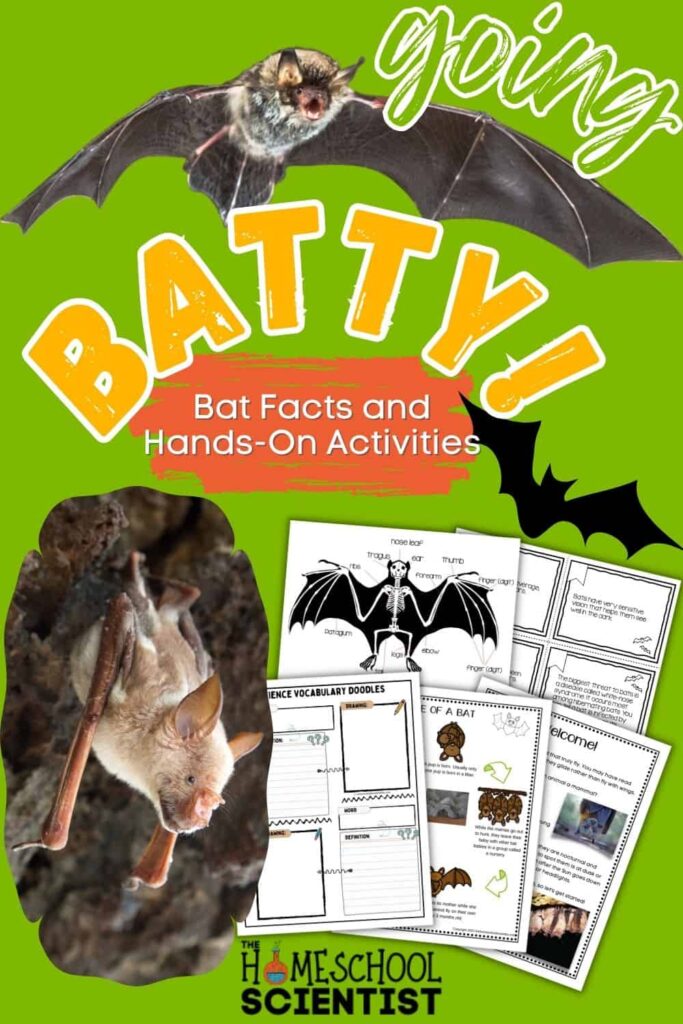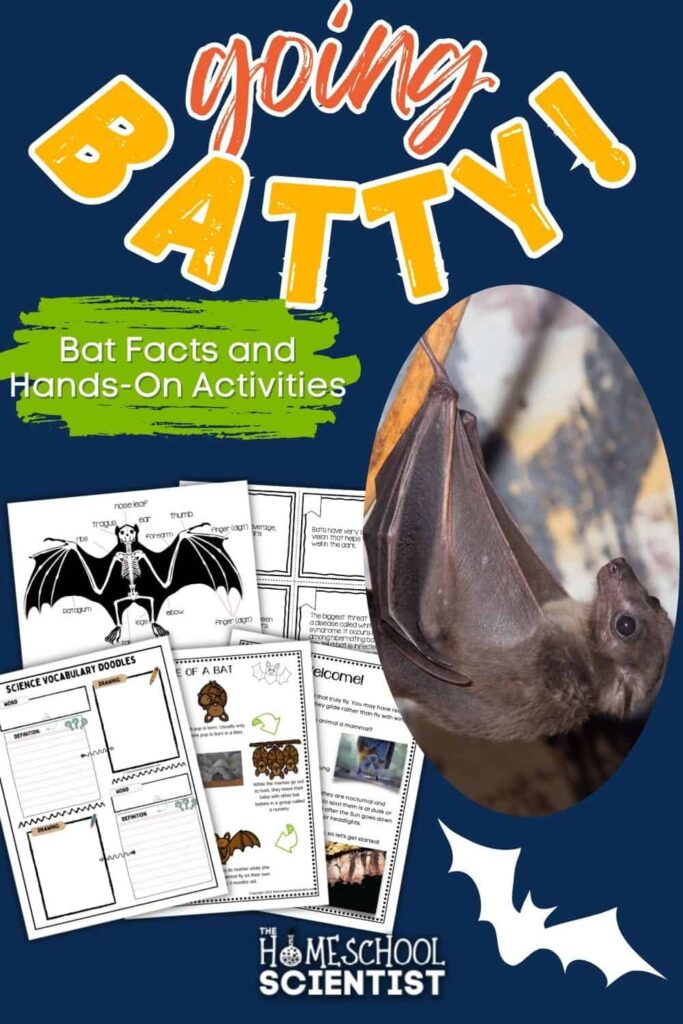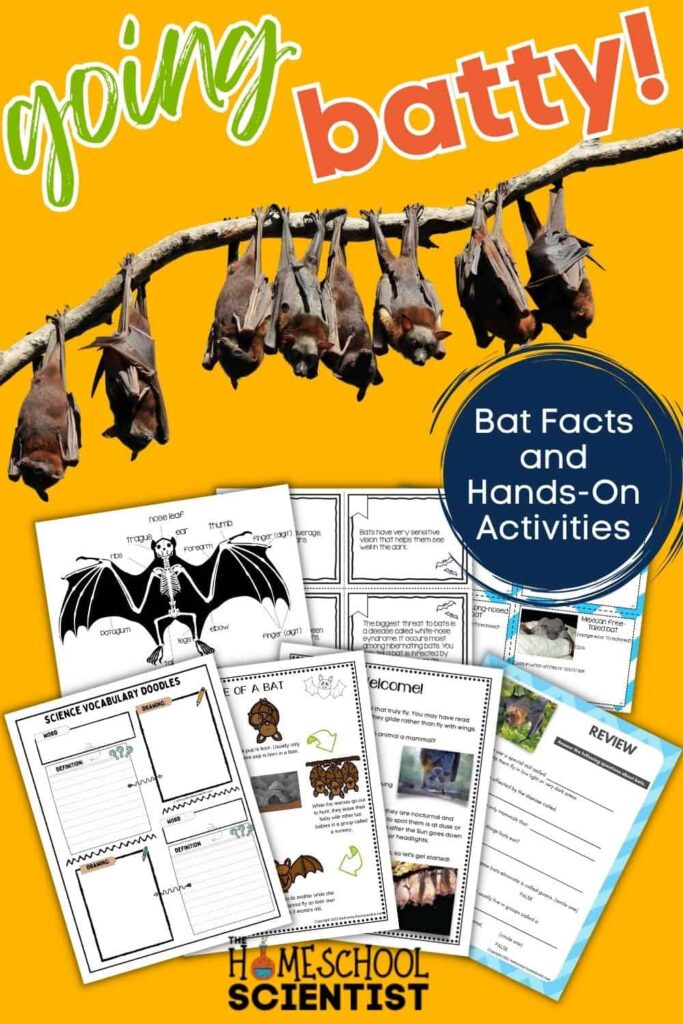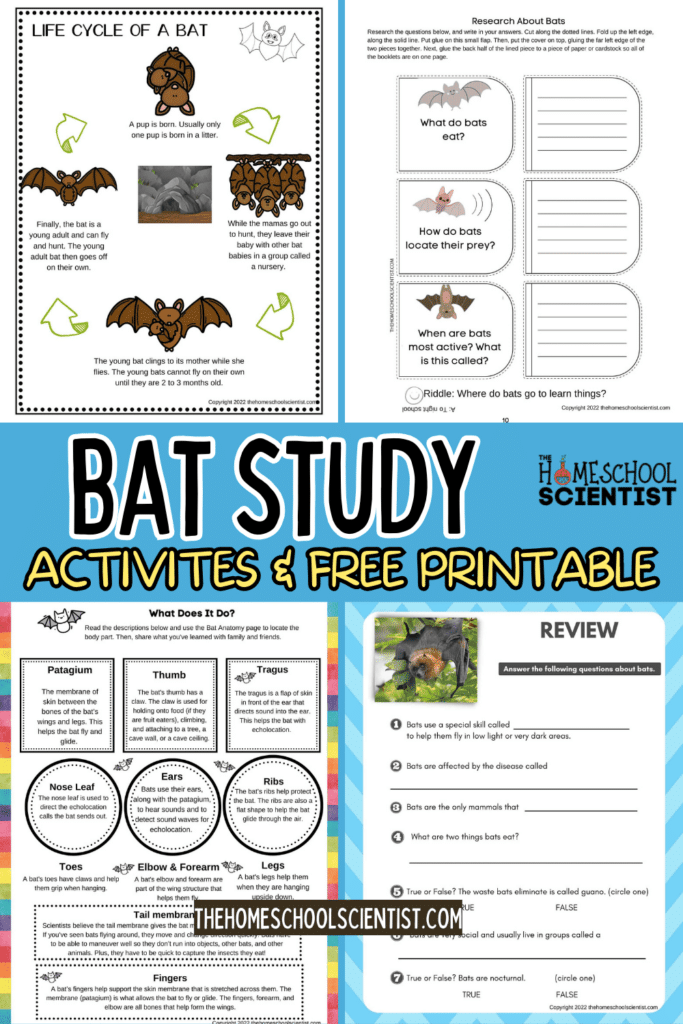Fascinating Bat Facts For Kids with Printable Lesson & STEM Activities
After reading through our bat facts for kids, download the FREE bat lesson with printable worksheets and 14 different activities. There are over 70 pages, including bat facts on printable cards, a batty STEM challenge, vocabulary, and much more.
There is a mystery that surrounds bats. It’s easy to spot a large cow or deer in a field, or even a quick rabbit in the yard. Bats, on the other hand, are usually only spotted if you are looking for them. It’s hard to see a small, swift, flying creature at night.
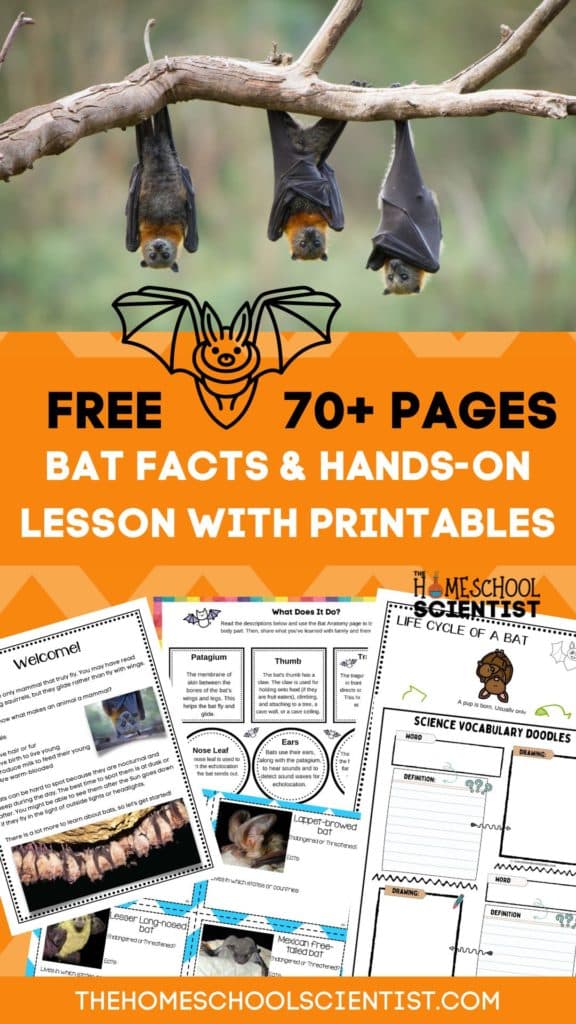
Table of Contents
Fascinating Bat Facts for Kids
The mysteriousness of bats drew me to them, but it’s their many other unique characteristics that really set them apart from other animals. Take a look at these bat facts, and I think you’ll be amazed by them too.
- Bats are mammals in the order Chiroptera. Chiroptera is made up of two Greek roots – chiro, which means “finger,” and ptera, which means “wing.”
- Bats are the only mammals capable of actual flight.
- Bats live in caves, but some bats live in trees.
- Bats are very social and usually live in groups called a colony.
- Bats are nocturnal, meaning they are active at night and sleep during the day.
- Bats are clean animals that regularly clean themselves.
- Bats are the second fastest mammal in the world (Cheetahs are the fastest.) Researchers recorded the Mexican free-tail bat flying at over 100 miles per hour. Most bats fly around 30 miles per hour.
- There are over 1,200 bat species worldwide.
- Bats make up 20% of the mammals on Earth.
- Bats find food in the dark by echolocation.
- Bats see very well. Bats have very sensitive vision which helps them see at night.
- Bats species have varying diets. Some eat insects. Others eat fruit or nectar, while others eat small animals. 70% of the bat species in the world only eat insects.
- Insect-eating bats eat moths, mosquitoes, gnats, mayflies, and beetles. Bats that eat beetles are a tremendous help to farmers because those beetles eat and destroy crops.
- Fruit and nectar-eating bats are good pollinators.
- Fruit-eating bats spread 90% of the seeds from the fruit they eat.
- Some bats can eat up to 3,000 mosquitoes in an hour.
- Little brown bats can eat 1,000 mosquitoes per hour.
- When bats eliminate waste, called guano, they are helping to fertilize plants and trees. Their guano contains a high amount of nitrogen. Nitrogen helps plants capture sunlight which is important for photosynthesis.
- Over 56% of the bat population in the U.S. is endangered or are in danger of being listed as endangered. Most recently, in December 2022, the northern long-eared bat moved to the endangered status. More information is here.
- Bats usually give birth to one pup at a time. But some bats can have 4 to 5 pups in one litter. The mama bat nurses her baby for about four to five weeks.
- Some bats migrate, some go into torpor throughout a colder season, and others hibernate.
- Bats can live, on average, about 20 years. Some bats live up to 30 years.
- The oldest a bat has been known to live is 41 years and lived in Siberia.
- The largest bat species in the world is the giant golden-crowned flying fox, with a weight of 2.5 pounds and a wingspan of over 5 feet!
- The world’s smallest bat is the bumblebee bat measuring up to 29 – 33 mm (1.1 –3 in) in length and 2 g (0.071 oz) in mass as a full-grown adult. Some sites list the Kitti’s hog-nosed bat as the smallest bat. In our printable, we list the bumble bee bat.
- The biggest threat to bats is a disease called white-nose syndrome. It occurs most among hibernating bats. You can tell a bat is infected by the white coloring on its muzzle. Animals that prey on bats include snakes, owls, and hawks.
- Bats that feed on fruit are called frugivores. The Jamaican fruit bat is a frugivore. Some flying foxes each fruit.
- Bats that feed on insects only are insectivorous. Of the 45 species of bats in the United States, 42 species are insectivorous.
- Bats are found in all areas of the world, except the Arctic, Antarctica, and some Oceanic islands. (Oceanic islands are also referred to as volcanic islands. They form out of volcanoes located on the ocean floor.)
DOWNLOAD OUR FREE 70+ PAGE LESSON AND PRINTABLES WITH BAT FACTS FOR KIDS, HANDS-ON ACTIVITIES, A FUN STEM CHALLENGE, AND MUCH MORE. SEE DOWNLOAD SECTION BELOW.
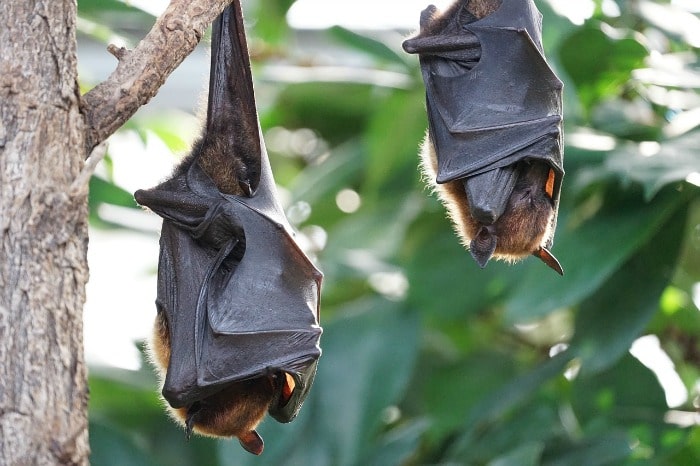
Bat Facts for Kids – Why Are Bat Populations Declining?
Bats are an important part of their ecosystem. They keep insect populations in check and are pollinators of plants. Sadly, in many areas of the U.S. and the rest of the world, bat numbers are in a steep decline. Over 56% percent of the U.S. species of bats are endangered. Why?
White-Nose Syndrome
The major threat to bats in the U.S. right now is White-Nose Syndrome . This is a fungus that is killing hibernating bat species in the United States in huge numbers. It is named for the white fungus that grows on the wings and noses of the bats. This fungus is suspected to be an introduced species and was first discovered in cave bats in New York in 2006. By 2016, White-Nose Syndrome spread to more than half of the U.S. states.
The fungus irritates the skin of the bats causing them to wake from their hibernation before it is time. This causes the bats to burn through their fat reserves too soon and they starve to death.
According to the U.S. Department of Interior, white-nose syndrome has, has killed over 90% of northern long-eared, little brown and tri-colored bat populations in less than 10 years.
Wind Turbines
Another proposed threat to bats is wind turbines. The growing wind energy industry is building an increasing number of turbines across the country. Bats and birds are being injured and killed by the rotating blades. More studies need to be done to give an accurate assessment of the numbers.
Habitat Destruction
When humans destroy natural areas, animal and plant habitat is destroyed. Sometimes species will move into another area. Other times there is no other areas with the proper food and habitat for that species. This causes the decline in population numbers
Learn Even More & Enjoy 14 Activities by Requesting Our FREE 70+ Page Bat Lesson and Printables
October is Bat Appreciation Month, so be ready with our ready-to-use lesson with printables and 14 activities.
Fill out the form below to subscribe to The Homeschool Scientist’s emails and a download link will be sent directly to your inbox. ===Please make sure you have pop-up’s allowed when you open the email and click the link to the PDF!===
Bat Facts for Kids – Echolocation
One of the most fascinating things about bats is their ability to use echolocation to hunt food and avoid collisions with other animals, trees, buildings, and other objects.
Bats use a special skill called echolocation to help them fly in low light or very dark areas without running into walls, trees, buildings, or other objects. Echolocation also helps them find food.
Bats make an ultrasonic sound. Ultrasonic sounds are very high-pitched. Humans cannot hear these sounds.
The sounds bounce off objects and the sound waves travel back, like an echo, to the bat’s ears. From these echos, the bat can determine where an object is, how far away it is, and how big it is. If the object is moving, the bat can detect the movement from the sound waves.
In the picture below, the white lines are the ultrasonic sounds the bat makes. The red lines are the sound waves bouncing off the butterfly and traveling back to the bat’s ears.
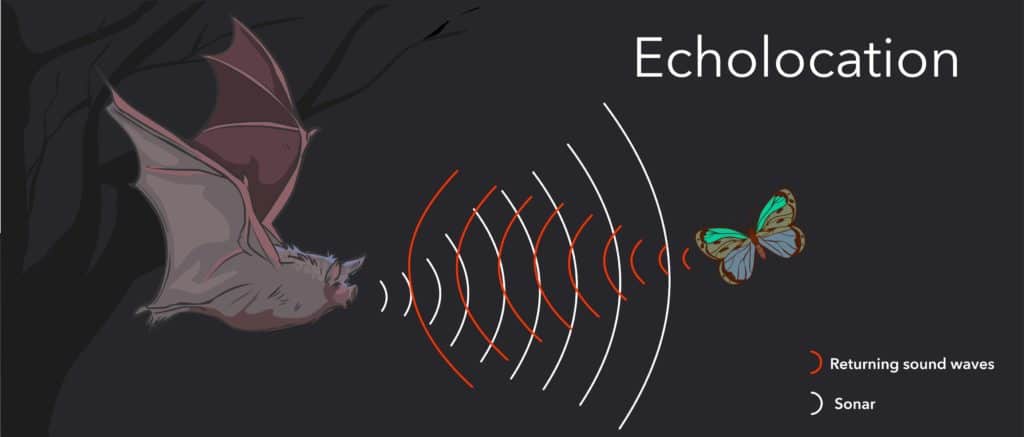
Bat Links
Here are some great links for further bat study.
- BatConservation.org
- White-Nose Syndrome.org
- Bat Conservation International
- What Is Killing The Bats?
- KidZone bats facts and activities
- Free Bat Unit Study
- Build Your Own Bat House
Learn about bats and other endangered species in The Homeschool Scientist’s endangered species series.
I hold a master’s degree in child development and early education and am working on a post-baccalaureate in biology. I spent 15 years working for a biotechnology company developing IT systems in DNA testing laboratories across the US. I taught K4 in a private school, homeschooled my children, and have taught on the mission field in southern Asia. For 4 years, I served on our state’s FIRST Lego League tournament Board and served as the Judging Director. I own thehomeschoolscientist and also write a regular science column for Homeschooling Today Magazine. You’ll also find my writings on the CTCMath blog. Through this site, I have authored over 50 math and science resources.



